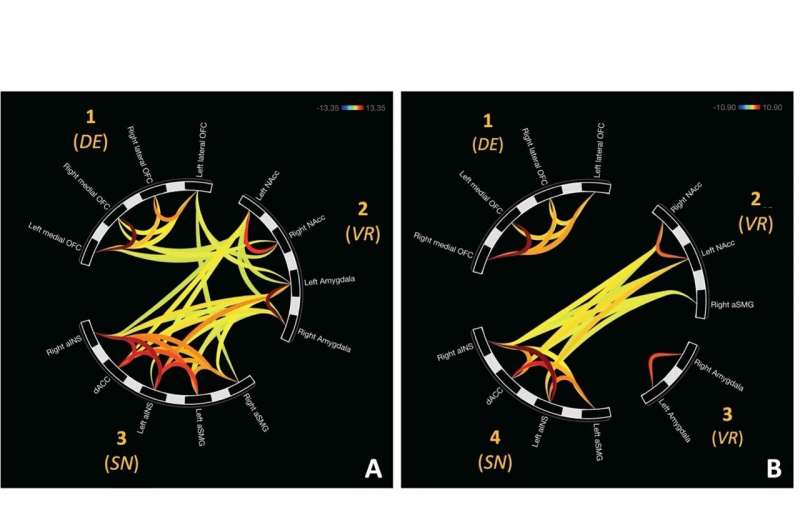October 31, 2023 feature
This article has been reviewed according to Science X's editorial process and policies. Editors have highlighted the following attributes while ensuring the content's credibility:
fact-checked
peer-reviewed publication
trusted source
proofread
Approaching and avoiding 'bad' decisions are linked with different neural communication patterns

Human decision-making has been the focus of countless neuroscience studies, which try to identify the neural circuits and brain regions that support different types of decisions. Some of these research efforts focus on the choices humans make while gambling and taking risks, yet the neural underpinnings of these choices have not yet been fully elucidated.
Researchers at University of Louisville carried out a study aimed at better understanding the patterns in neural network communication associated with 'bad' decisions made while gambling. Their paper, published in Frontiers in Neuroscience, shows that different types of 'bad' decisions made while gambling, namely avoidant and approach decisions, are associated with distinct neural communication patterns.
"Our recent work follows a line of research that examines how humans approach rewarding and punishing situations in the environment," Brendan Depue and Siraj Lyons, the researchers who carried out the study, told Medical Xpress.
"Some people tend to seek out reward, while others are more passive. In situations where ambiguity exists, people with certain personality traits are more willing to approach such decisions and others avoid them, due to the ambiguity of the situation. We wanted to know whether these types of personality traits were apparent in a gambling task during fMRI and whether we could reliably measure neural differences associated with approach and avoid, during ambiguous situations."
As part of their study, Lyons and Depue set out to better understand the neural communication patterns associated with two different types of decisions that can be made while gambling, so-called avoidant and approach decisions. Avoidant decisions entail avoiding gambling during specific rounds of a game, while approach entails taking a risk and deciding to 'play' during a round of gambling.
To explore the neural communication supporting these two different types of decisions, the researchers asked 24 participants to gamble in a well-known experimental task, known as the Iowa Gambling Task. People participating in this task need to decide whether to 'play' (i.e., gamble) or 'pass' (i.e., avoid gambling) while playing a game using card decks.
"The decks we used range from high to low probability of a reward and people learn the probability outcomes over time," Lyons and Depue explained. "We scanned individual participants with functional magnetic resonance imaging (fMRI) to understand the brain's activity and connectivity when they made these decisions. We used the latest neuroimaging analyses to then test several regions that are known to underlie decision making and reward to see how they communicated with each other during times of play vs. pass, or approach vs. avoid."
During the experimental trials, Lyons and Depue also observed and recorded the behavioral choices of the study participants, or in other words, how many times they decided to 'pass' and 'play'. They then examined fMRI scans they collected to determine what happened in their brain while they decided to 'pass' and 'play.'
"We found that when people make bad decisions, hence decisions where they avoid high reward probability and approach low reward probability, there appears to be different neural communication involved," Lyons and Depue said. "Avoiding high probability of reward situations leads to more communication between the brains reward and executive function networks, while approaching low probability or reward situations, leads to less communication between the same brain regions."
In their paper, Lyons and Depue offer an interesting interpretation for their findings. Specifically, they suggest that avoidant decisions, which typically take a longer time, are associated with more careful decision-making, while approaching decisions, which are generally made quickly, tend to be more impulsive.
The evidence that the researchers gathered so far appears to support this hypothesis. In the future, their work could inform additional research efforts aimed at testing this hypothesis further, which could, in turn, shed some new light on the brain processes underpinning gambling and risky decision making.
"We are now continuing this line of research to understand how reinforcing and punishing such rewards alters learning and subsequent decision making," Lyons and Depue added. "We hope to uncover how people learn about rewarding or punishing situations and which personality characteristics are attributed to such decisions."
More information: Siraj Lyons et al, Not all bad decisions are alike: approach and avoidant bad decisions are associated with distinct network organization, Frontiers in Neuroscience (2023). DOI: 10.3389/fnins.2023.1249008
© 2023 Science X Network




















